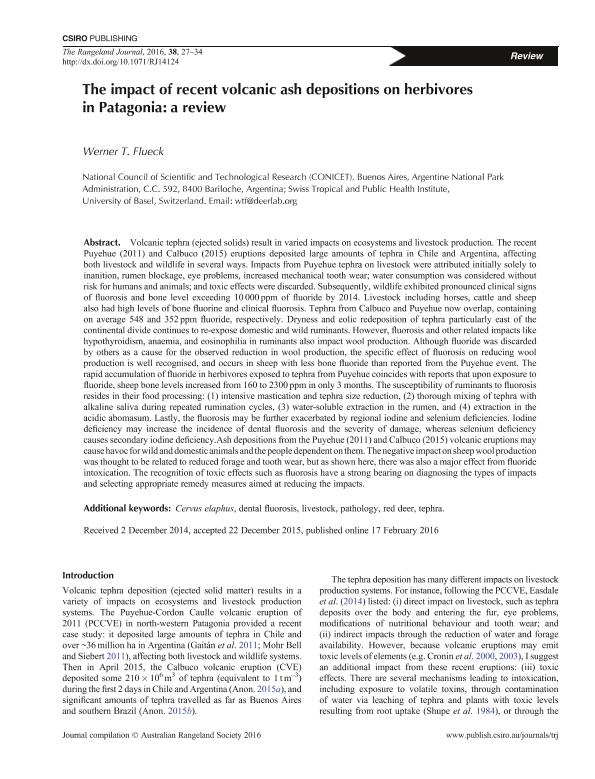Mostrar el registro sencillo del ítem
dc.contributor.author
Fluck, Werner Thomas

dc.date.available
2018-09-19T15:48:44Z
dc.date.issued
2016-02
dc.identifier.citation
Fluck, Werner Thomas; The impact of recent volcanic ash depositions on herbivores in Patagonia: A review; Australian Rangeland Society; Rangeland Journal; 38; 1; 2-2016; 27-34
dc.identifier.issn
1036-9872
dc.identifier.uri
http://hdl.handle.net/11336/60227
dc.description.abstract
Volcanic tephra (ejected solids) result in varied impacts on ecosystems and livestock production. The recent Puyehue (2011) and Calbuco (2015) eruptions deposited large amounts of tephra in Chile and Argentina, affecting both livestock and wildlife in several ways. Impacts from Puyehue tephra on livestock were attributed initially solely to inanition, rumen blockage, eye problems, increased mechanical tooth wear; water consumption was considered without risk for humans and animals; and toxic effects were discarded. Subsequently, wildlife exhibited pronounced clinical signs of fluorosis and bone level exceeding 10000ppm of fluoride by 2014. Livestock including horses, cattle and sheep also had high levels of bone fluorine and clinical fluorosis. Tephra from Calbuco and Puyehue now overlap, containing on average 548 and 352ppm fluoride, respectively. Dryness and eolic redeposition of tephra particularly east of the continental divide continues to re-expose domestic and wild ruminants. However, fluorosis and other related impacts like hypothyroidism, anaemia, and eosinophilia in ruminants also impact wool production. Although fluoride was discarded by others as a cause for the observed reduction in wool production, the specific effect of fluorosis on reducing wool production is well recognised, and occurs in sheep with less bone fluoride than reported from the Puyehue event. The rapid accumulation of fluoride in herbivores exposed to tephra from Puyehue coincides with reports that upon exposure to fluoride, sheep bone levels increased from 160 to 2300ppm in only 3 months. The susceptibility of ruminants to fluorosis resides in their food processing: (1) intensive mastication and tephra size reduction, (2) thorough mixing of tephra with alkaline saliva during repeated rumination cycles, (3) water-soluble extraction in the rumen, and (4) extraction in the acidic abomasum. Lastly, the fluorosis may be further exacerbated by regional iodine and selenium deficiencies. Iodine deficiency may increase the incidence of dental fluorosis and the severity of damage, whereas selenium deficiency causes secondary iodine deficiency.
dc.format
application/pdf
dc.language.iso
eng
dc.publisher
Australian Rangeland Society

dc.rights
info:eu-repo/semantics/openAccess
dc.rights.uri
https://creativecommons.org/licenses/by-nc-sa/2.5/ar/
dc.subject
Cervus Elaphus
dc.subject
Dental Fluorosis
dc.subject
Livestock
dc.subject
Pathology
dc.subject
Red Deer
dc.subject
Tephra.
dc.subject.classification
Meteorología y Ciencias Atmosféricas

dc.subject.classification
Ciencias de la Tierra y relacionadas con el Medio Ambiente

dc.subject.classification
CIENCIAS NATURALES Y EXACTAS

dc.title
The impact of recent volcanic ash depositions on herbivores in Patagonia: A review
dc.type
info:eu-repo/semantics/article
dc.type
info:ar-repo/semantics/artículo
dc.type
info:eu-repo/semantics/publishedVersion
dc.date.updated
2018-09-14T14:02:18Z
dc.journal.volume
38
dc.journal.number
1
dc.journal.pagination
27-34
dc.journal.pais
Australia

dc.description.fil
Fil: Fluck, Werner Thomas. Consejo Nacional de Investigaciones Científicas y Técnicas; Argentina. Administración de Parques Nacionales; Argentina. Universidad de Basilea; Suiza
dc.journal.title
Rangeland Journal

dc.relation.alternativeid
info:eu-repo/semantics/altIdentifier/doi/https://dx.doi.org/10.1071/RJ14124
dc.relation.alternativeid
info:eu-repo/semantics/altIdentifier/url/http://www.publish.csiro.au/rj/RJ14124
Archivos asociados
